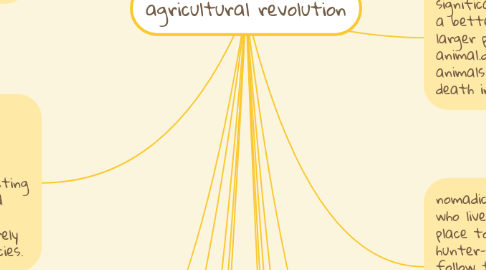agricultural revolution
by Prisha Singh

1. Guidelines
1.1. Anything goes!
1.2. No criticism or flaming allowed
1.3. The Wilder The Better
1.4. Quantity is Quality
1.5. Set a Time Limit
2. agrarian society-an agrarian society is any society whose economy is based on producing and maintaining crops and farmland. Another way to define agrarian society is by seeing how much of a nation's total production is in agriculture.
3. hunter-gather society-a hunter-gather society is a human living in a society in which most or all food is obtained by foraging (collecting wild plants and pursuing wild animals), in contrast to agriculture societies, which rely mainly on domesticated species.
4. irrigation-irrigation management importance.... irrigation is the artificial exploitation and distribution of water at project level aiming at application of water at field level to agriculture crops in dry areas or in periods of scarce rainfall to assure or improve crop production.
5. climate-climate change affects agriculture in a number of ways,including through changes in average temperatures,rainfall,and climate extremes.
6. hunting-catch and release also increases the risk of spreading wild life diseases......fur trapping plays an important role in wild life monitoring,species,protection and conservation research.capturing wild animals as well as observing changes in the animals and their habitats is necessary parts of wild life conservation efforts.
7. food storage-the safe storage of food for home use should strictly adhere to guidelines set out by reliable resourses,such as thne united states department of agriculture....it is also imp to maintain proper kitchen hygiene,to reduce risks of bacteria or virus growth and food poisining.
8. population increase-progress is hindered by a poor appreciation of how demographc factors affect the action of a natural selection. i review life history,theory showing that the quantity maximised by selection depends on weather and how population growth is regulated.
9. culture-it creates identification,it is learned and passed on from the older generations to the newer ones,by keeping the culture alive and fresh.it bonds people,establishes principles,stand apart in foreign countries.
10. animal domestication-the significance of domestication is a better food source and a larger population of the animal.domestication of certain animals prevents unnecessary death in the animal world.
11. nomadic-a nomad is someone who lives by traveling from place to place.Nomadic hunter-gatherer tribes follow the animals they hunt, carrying tents with them. You don't have to be a nomad to live a nomadic lifestyle.
12. womens roles-the loss of biodiversity in india and specifically food crops is a serious concern of food security and sustainability of the agricultural sector in india...both ceremonies celeberate the role of women in agriculture and fertility and importance of environment and biodiversity.
13. small scale fishiries and aquaculture make critical contributions to development in the areas of employment,with over 41 million people worldwide,the vast majority of whom live in developing countries,working in fish production,food security and nutrition,with fish constituting an important sourse of nutrients for
14. water-the importance of water relates to its essential functions in perpetuating both plant and animal life....in crop agriculture,water is an important climatic factor.it affects or determines plant growth and development.
15. transportation-transport or transportation is the movement of human,animals and goods from one location to another. modes of transport include air,rail,road,water,cable,pipeline and space.....transport is imp because it enables trade between people,wcich is essential for the development of the civilizations.
16. villages and cities-a city is a large human settlement..a village is clustered human settlement ora community,larger than a hamlet.


